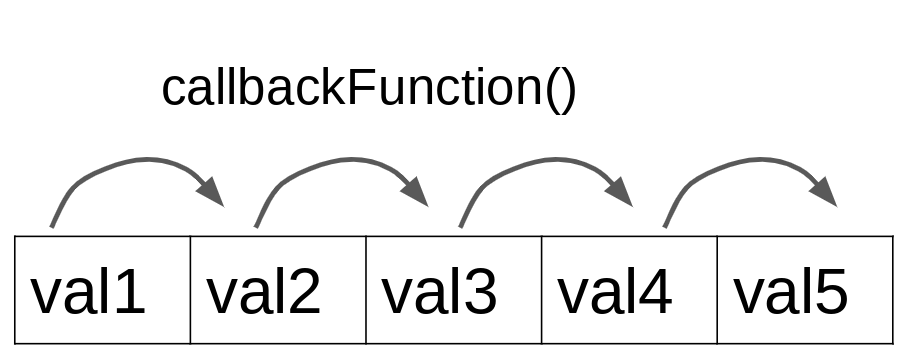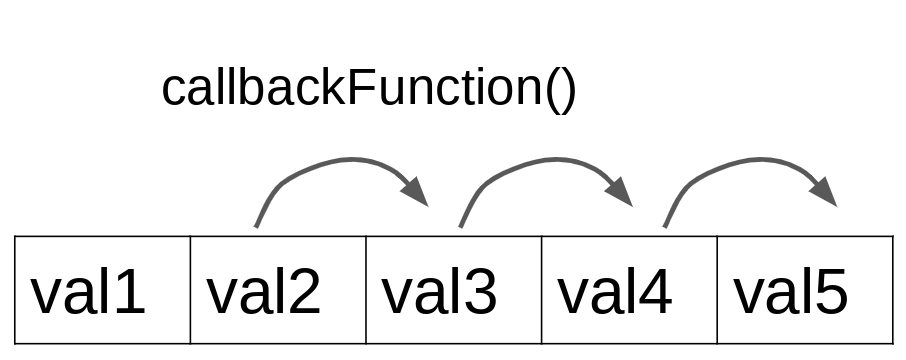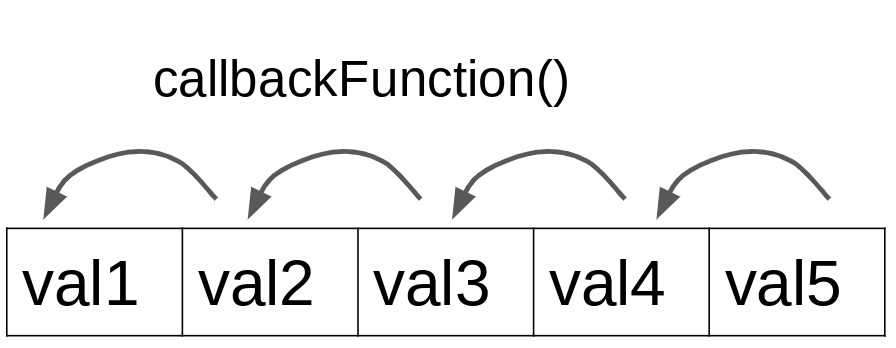The Array methods reduce() and reduceRight() in Apps Script
The Array method reduce() reduces values in an array to a single value. The method reduceRight() does the same thing but it traverses the array from right to left. Aside from the order of traversal, both of these functions work in the same way.
Let us say we want to compute the sum of all numbers in the array [1,2,3]. You can use the reduce() method to do this since we're reducing the values in this array to a single value, their sum.
Prerequisites
This tutorial assumes that you're familiar with:
Syntaxarray.reduce(callbackFunction, initialValue)
Parameters
array.reduce(callbackFunction, initialValue)callbackFunction (required):
This function will be executed once for every element in the array. The output returned by each execution is passed as input to the next execution.
The
callbackFunctioncan accept four arguments:previousOutput(required): The output value returned by the previous execution.value(required): The current value being processed.index(optional): The index of the value in the array.array(optional): The original array that thereduce()method was called on.
initialValue (optional):
If supplied, this initial value will be made available as the "previousOutput" when the callbackFunction is executed for the first element in the array. If it is not supplied, the first value in the array will be used as the "previousOutput" and the execution will begin
Return value
The reduce() method "reduces'' an array to a single value. It executes the callbackFunction on every element of the original array. Each time, the output from the previous execution is made available to the current execution. The final output returned when the callbackFunction is executed for the last element in the array is returned by the reduce() method.
How does the reduce() Array method work?
When the reduce() method is used on an array of values using a callback function, the callback function will be executed once for every value in the array. You can think of this as the callback function visiting each element of the array. In every visit, it remembers the output from its visit to the previous element in the array.
If you supply an initial value, the callback function will begin by visiting the first element in the array and the initial value will be treated as the previous output.

If you do not supply an initial value, the callback function will begin by visiting the second element in the array and the first element will be treated as the previous output.

In both of the above cases, the output from the first visit will be used as the previous output when the callback function visits the next element in the array. In this manner, the callback function is able to keep track of the updated output as it visits all the elements in the array. Finally, when it visits the last element in the array, its output from this final visit will be returned by the reduce() method.
Illustrative example
Let us say we want to sum the values in the array [1,2,3] using the reduce() method. Consider the following function that we will use as the callback function. It accepts two parameters and returns their sum.
function sum(previousOutput, currentValue) {
return previousOutput + currentValue;
}Suppose we do NOT provide an initial value while reducing the array, the callback function will begin by visiting the second element in the array and the first element will be used as the previous output.
function sum(previousOutput, currentValue) {
return previousOutput + currentValue;
}
function reduceToSum() {
let values = [1,2,3];
return values.reduce(sum);
} In this case, the execution will proceed as follows:
previousOutput | currentValue | What is executed? | output returned | Notes |
|---|---|---|---|---|
1 | 2 | sum(1,2) | 3 | Since no initial value was supplied, the callback function begins by visiting the second element in the array |
3 | 3 | sum(3,3) | 6 | The callback function moves on to the next element in the array, which is also the last element. The value |
Now, suppose we provide the initial value 0 while reducing the array. The callback function will begin by visiting the first element in the array and the initial value will be used as the previous output.
previousOutput | currentValue | What is executed? | output returned | Notes |
|---|---|---|---|---|
0 | 1 | sum(0,1) | 1 | Since |
1 | 2 | sum(1,2) | 3 | The callback function moves on to the next element in the array, which is the second element. The value |
3 | 3 | sum(3,3) | 6 | The callback function moves on to the next element in the array, which is also the last element. The value |
In both cases, the array of values was reduced to the same output using the sum() callback function. However, the sequence of steps was different depending on whether an initial value was supplied or not.
The reduceRight() method
The reduceRight() method works exactly like the reduce() method, except that it moves through an array from right to left versus left to right.

ExamplesExample 1: Using the reduce() Array method to sum values in an array.
Example 1.1: Sum values in an array without supplying an initial value
In the code below, the function sum(previousValue, currentValue) is the callback function that is supplied to the reduce() method. This function reduces the array of numbers to a single value, which is the sum of those values.
function reduceEx1_1() {
var value = [1,2,3];
Logger.log(value.reduce(sum));
}
function sum(previousValue, currentValue) {
return previousValue + currentValue;
}Output
6.0
Example 1.2: Sum values in an array with supplying an initial value
Now, in addition to supplying a callback function, we will also supply an initial starting value. Since our goal is to sum the values in the array, we will supply an initial value of 0: value.reduce(sum, 0). Here, sum is the callbackFunction and 0 is the initial value. The output returned will be the same as in example 1.1 because adding the value 0 to the sum will not change the sum.
function reduceEx1_2() {
var value = [1,2,3];
Logger.log(value.reduce(sum, 0));
}
function sum(previousValue, currentValue) {
return previousValue + currentValue;
}Output
6.0
Example 2: Using the reduce() and reduceRight() Array methods to concatenate values in an array.Example 2.1: Using the reduce() array method to concatenate values in an array
Consider the array of characters ["h", "e", "l", "l", "o"]. The code below reduces these values to a single value by concatenating them together.
function reduceEx2_1() {
var value = ["h", "e", "l", "l", "o"];
Logger.log(value.reduce(concat));
}
function concat(previousValue, currentValue) {
return previousValue + currentValue;
}Output
hello
Example 2.2: Using the reduceRight() array method to concatenate values in an array
Now, we'll do the same thing as example 2.1 except we will use the reduceRight() method instead of the reduce() method. Since the reduceRight() method moves from right to left, the order of characters in the concatenated string will be reversed.
Note
Notice that the callback function, concat(), in both examples 2.1 and 2.2 is exactly the same. Reducing the array ["h", "e", "l", "l", "o"] from left to right using this callback function produces "hello" and from right to left produces "olleh". The core "business logic" here is the same: a function that concatenates values. What is different is the order in which this function visits data, which in this case is values in an array.
function reduceEx2_2() {
var value = ["h", "e", "l", "l", "o"];
Logger.log(value.reduceRight(concat));
}
function concat(previousValue, currentValue) {
return previousValue + currentValue;
}Output
olleh
Conclusion
In this tutorial, you learned how to use the reduce() and reduceRight() Array methods. These methods reduce values in an array to a single value. The reduce() method moves through the array from left to right and the reduceRight() method moves from right to left.
How was this tutorial?
Your feedback helps me create better content
DISCLAIMER: This content is provided for educational purposes only. All code, templates, and information should be thoroughly reviewed and tested before use. Use at your own risk. Full Terms of Service apply.
Small Scripts, Big Impact
Join 1,500+ professionals who are supercharging their productivity with Google Sheets™ automation
By subscribing, you agree to our Privacy Policy and Terms of Service

